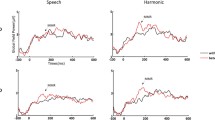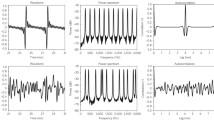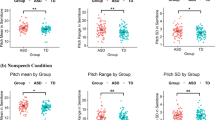Abstract
The present study investigated pitch processing in Mandarin-speaking children with autism using event-related potential measures. Two experiments were designed to test how acoustic, phonetic and semantic properties of the stimuli contributed to the neural responses for pitch change detection and involuntary attentional orienting. In comparison with age-matched (6–12 years) typically developing controls (16 participants in Experiment 1, 18 in Experiment 2), children with autism (18 participants in Experiment 1, 16 in Experiment 2) showed enhanced neural discriminatory sensitivity in the nonspeech conditions but not for speech stimuli. The results indicate domain specificity of enhanced pitch processing in autism, which may interfere with lexical tone acquisition and language development for children who speak a tonal language.


Similar content being viewed by others
References
American Psychiatric Association. (1994). Diagnostic and statistical manual of mental disorders (4th ed.). Washington, DC: American Psychiatric Association.
American Psychiatric Association. (2000). Diagnostic and statistical manual of mental disorders (4 text revision ed.). Washington, DC: American Psychiatric Association.
American Psychiatric Association. (2013). Diagnostic and statistical manual of mental disorders (5th ed.). Washington, DC: American Psychiatric Association.
Autism Society of America. (1994). Definition of autism. The Advocate: Newsletter of the Autism Society of American Journal of Psychiatry, 26(2), 3.
Boersma, P., & Weenink, D. (2014). Praat: Doing phonetics by computer (Version 5. 3. 79) [Computer program]. Retrieved from http://www.praat.org/
Boets, B., Verhoeven, J., Wouters, J., & Steyaert, J. (2014). Fragile spectral and temporal auditory processing in adolescents with autism spectrum disorder and early language delay. Journal of Autism and Developmental Disorders,. doi:10.1007/s10803-014-2341-1.
Bonnel, A., McAdams, S., Smith, B., Berthiaume, C., Bertone, A., Ciocca, V., & Mottron, L. (2010). Enhanced pure-tone pitch discrimination among persons with autism but not Asperger syndrome. Neuropsychologia, 48(9), 2465–2475. doi:10.1016/j.neuropsychologia.2010.04.020.
Bonnel, A., Mottron, L., Peretz, I., Trudel, M., Gallun, E., & Bonnel, A. M. (2003). Enhanced pitch sensitivity in individuals with autism: a signal detection analysis. Journal of Cognitive Neuroscience, 15(2), 226–235. doi:10.1162/089892903321208169.
Čeponienė, R., Lepistö, T., Shestakova, A., Vanhala, R., Alku, P., Näätänen, R., & Yaguchi, K. (2003). Speech-sound-selective auditory impairment in children with autism: They can perceive but do not attend. Proceedings of the National Academy of Sciences USA, 100(9), 5567–5572. doi:10.1073/pnas.0835631100.
Chandrasekaran, B., Krishnan, A., & Gandour, J. T. (2007). Mismatch negativity to pitch contours is influenced by language experience. Brain Research, 1128(1), 148–156. doi:10.1016/j.brainres.2006.10.064.
Chandrasekaran, B., Krishnan, A., & Gandour, J. T. (2009). Relative influence of musical and linguistic experience on early cortical processing of pitch contours. Brain and Language, 108(1), 1–9. doi:10.1016/j.bandl.2008.02.001.
Dawson, M., Soulieres, I., Gernsbacher, M. A., & Mottron, L. (2007). The level and nature of autistic intelligence. Psychological Science, 18(8), 657–662. doi:10.1111/j.1467-9280.2007.01954.x.
Dawson, G., Toth, K., Abbott, R., Osterling, J., Munson, J., Estes, A., & Liaw, J. (2004). Early social attention impairments in autism: Social orienting, joint attention, and attention to distress. Developmental Psychology, 40(2), 271–283. doi:10.1037/0012-1649.40.2.271.
Eigsti, I. M., & Fein, D. A. (2013). More is less: pitch discrimination and language delays in children with optimal outcomes from autism. Autism Research, 6(6), 605–613. doi:10.1002/aur.1324.
Escera, C., Alho, K., Winkler, I., & Näätänen, R. (1998). Neural mechanisms of involuntary attention to acoustic novelty and change. Journal of Cognitive Neuroscience, 10(5), 590–604. doi:10.1162/089892998562997.
Ferri, R., Elia, M., Agarwal, N., Lanuzza, B., Musumeci, S. A., & Pennisi, G. (2003). The mismatch negativity and the P3a components of the auditory event-related potentials in autistic low-functioning subjects. Clinical Neurophysiology, 114(9), 1671–1680. doi:10.1016/s1388-2457(03)00153-6.
Fromkin, V. A., Curtiss, S., Hayes, B. P., Hyams, N., Keating, P. A., Koopman, H., & Steriade, D. (2000). Linguistics: An introduction to linguistic theory. Oxford: Blackwell Oxford.
Gage, N. M., Siegel, B., Callen, M., & Roberts, T. P. (2003). Cortical sound processing in children with autism disorder: An MEG investigation. NeuroReport, 14(16), 2047–2051. doi:10.1097/01.wnr.0000090030.46087.4a.
Gilliam, J. E. (2006). Gilliam autism rating scale (2nd ed.). Austin, TX: PRO-ED.
Gomot, M., Blanc, R., Clery, H., Roux, S., Barthelemy, C., & Bruneau, N. (2011). Candidate electrophysiological endophenotypes of hyper-reactivity to change in autism. Journal of Autism and Developmental Disorders, 41(6), 705–714. doi:10.1007/s10803-010-1091-y.
Gomot, M., Giard, M. H., Adrien, J. L., Barthelemy, C., & Bruneau, N. (2002). Hypersensitivity to acoustic change in children with autism: Electrophysiological evidence of left frontal cortex dysfunctioning. Psychophysiology, 39(5), 577–584. doi:10.1017/S0048577202394058.
Haesen, B., Boets, B., & Wagemans, J. (2011). A review of behavioural and electrophysiological studies on auditory processing and speech perception in autism spectrum disorders. Research in Autism Spectrum Disorders, 5(2), 701–714. doi:10.1016/j.rasd.2010.11.006.
Happé, F., & Frith, U. (2006). The weak coherence account: Detail-focused cognitive style in autism spectrum disorders. Journal of Autism and Developmental Disorders, 36(1), 5–25. doi:10.1007/s10803-005-0039-0.
Heaton, P. (2003). Pitch memory, labelling and disembedding in autism. Journal of Child Psychology and Psychiatry, 44(4), 543–551. doi:10.1111/1469-7610.00143.
Heaton, P. (2005). Interval and contour processing in autism. Journal of Autism and Developmental Disorders, 35(6), 787–793. doi:10.1007/s10803-005-0024-7.
Heaton, P., Hermelin, B., & Pring, L. (1998). Autism and pitch processing: A precursor for savant musical ability? Music Perception, 15(3), 291–305.
Heaton, P., Hudry, K., Ludlow, A., & Hill, E. (2008a). Superior discrimination of speech pitch and its relationship to verbal ability in autism spectrum disorders. Cognitive Neuropsychology, 25(6), 771–782. doi:10.1080/02643290802336277.
Heaton, P., Williams, K., Cummins, O., & Happé, F. (2008b). Autism and pitch processing splinter skills: A group and subgroup analysis. Autism, 12(2), 203–219. doi:10.1177/1362361307085270.
Hitoglou, M., Ververi, A., Antoniadis, A., & Zafeiriou, D. I. (2010). Childhood autism and auditory system abnormalities. Pediatric Neurology, 42(5), 309–314. doi:10.1016/j.pediatrneurol.2009.10.009.
Huang, A. X., Jia, M., & Wheeler, J. J. (2013). Children with autism in the People’s Republic of China: Diagnosis, legal issues, and educational services. Journal of Autism and Developmental Disorders, 43(9), 1991–2001. doi:10.1007/s10803-012-1722-6.
Jansson-Verkasalo, E., Čeponienė, R., Kielinen, M., Suominen, K., Jäntti, V., Linna, S.-L., & Näätänen, R. (2003). Deficient auditory processing in children with Asperger Syndrome, as indexed by event-related potentials. Neuroscience Letters, 338(3), 197–200. doi:10.1016/s0304-3940(02)01405-2.
Järvinen-Pasley, A., Wallace, G. L., Ramus, F., Happé, F., & Heaton, P. (2008). Enhanced perceptual processing of speech in autism. Developmental Science, 11(1), 109–121. doi:10.1111/j.1467-7687.2007.00644.x.
Jones, C. R., Happé, F., Baird, G., Simonoff, E., Marsden, A. J., Tregay, J., & Charman, T. (2009). Auditory discrimination and auditory sensory behaviours in autism spectrum disorders. Neuropsychologia, 47(13), 2850–2858. doi:10.1016/j.neuropsychologia.2009.06.015.
Kikuchi, Y., Senju, A., Tojo, Y., Osanai, H., & Hasegawa, T. (2009). Faces do not capture special attention in children with autism spectrum disorder: A change blindness study. Child Development, 80(5), 1421–1433. doi:10.1111/j.1467-8624.2009.01342.x.
Klin, A., Lin, D. J., Gorrindo, P., Ramsay, G., & Jones, W. (2009). Two-year-olds with autism orient to non-social contingencies rather than biological motion. Nature, 459(7244), 257–261. doi:10.1038/nature07868.
Kuhl, P. K. (2010). Brain mechanisms in early language acquisition. Neuron, 67(5), 713–727. doi:10.1016/j.neuron.2010.08.038.
Kuhl, P. K., Coffey-Corina, S., Padden, D., & Dawson, G. (2005). Links between social and linguistic processing of speech in preschool children with autism: Behavioral and electrophysiological measures. Developmental Science, 8(1), F1–F12. doi:10.1111/j.1467-7687.2004.00384.x.
Kujala, T., Aho, E., Lepistö, T., Jansson-Verkasalo, E., Nieminen-von Wendt, T., von Wendt, L., & Näätänen, R. (2007). Atypical pattern of discriminating sound features in adults with Asperger syndrome as reflected by the mismatch negativity. Biological Psychology, 75(1), 109–114. doi:10.1016/j.biopsycho.2006.12.007.
Kujala, T., Lepistö, T., & Näätänen, R. (2013). The neural basis of aberrant speech and audition in autism spectrum disorders. Neuroscience and Biobehavioral Reviews, 37(4), 697–704. doi:10.1016/j.neubiorev.2013.01.006.
Lepistö, T., Kajander, M., Vanhala, R., Alku, P., Huotilainen, M., Näätänen, R., & Kujala, T. (2008). The perception of invariant speech features in children with autism. Biological Psychology, 77(1), 25–31. doi:10.1016/j.biopsycho.2007.08.010.
Lepistö, T., Kujala, T., Vanhala, R., Alku, P., Huotilainen, M., & Näätänen, R. (2005). The discrimination of and orienting to speech and non-speech sounds in children with autism. Brain Research, 1066(1–2), 147–157. doi:10.1016/j.brainres.2005.10.052.
Lepistö, T., Nieminen-von Wendt, T., von Wendt, L., Näätänen, R., & Kujala, T. (2007). Auditory cortical change detection in adults with Asperger syndrome. Neuroscience Letters, 414(2), 136–140. doi:10.1016/j.neulet.2006.12.009.
Liberman, A. M., Harris, K. S., Hoffman, H. S., & Griffith, B. C. (1957). The Discrimination of speech sounds within and across phoneme boundaries. Journal of Experimental Psychology, 54(5), 358–368. doi:10.1037/H0044417.
Lord, C., Risi, S., Lambrecht, L., Cook, E. H, Jr, Leventhal, B. L., DiLavore, P. C., & Rutter, M. (2000). The autism diagnostic observation schedule-generic: A standard measure of social and communication deficits associated with the spectrum of autism. Journal of Autism and Developmental Disorders, 30(3), 205–223. doi:10.1023/A:1005592401947.
Lord, C., Rutter, M., & Le Couteur, A. (1994). Autism Diagnostic Interview-Revised: A revised version of a diagnostic interview for caregivers of individuals with possible pervasive developmental disorders. Journal of Autism and Developmental Disorders, 24(5), 659–685. doi:10.1007/BF02172145.
Markram, K., & Markram, H. (2010). The intense world theory—A unifying theory of the neurobiology of autism. Frontiers in Human Neuroscience, 4, 224. doi:10.3389/fnhum.2010.00224.
Mayer, J. L., Hannent, I., & Heaton, P. F. (2014). Mapping the developmental trajectory and correlates of enhanced pitch perception on speech processing in adults with ASD. Journal of Autism and Developmental Disorders,. doi:10.1007/s10803-014-2207-6.
Mottron, L., Bouvet, L., Bonnel, A., Samson, F., Burack, J. A., Dawson, M., & Heaton, P. (2013). Veridical mapping in the development of exceptional autistic abilities. Neuroscience and Biobehavioral Reviews, 37(2), 209–228. doi:10.1016/j.neubiorev.2012.11.016.
Mottron, L., Dawson, M., Soulieres, I., Hubert, B., & Burack, J. (2006). Enhanced perceptual functioning in autism: An update, and eight principles of autistic perception. Journal of Autism and Developmental Disorders, 36(1), 27–43. doi:10.1007/s10803-005-0040-7.
Mundy, P., & Neal, A. R. (2000). Neural plasticity, joint attention, and a transactional social-orienting model of autism. International review of research in mental retardation, 23, 139–168. doi:10.1016/S0074-7750(00)80009-9.
Näätänen, R., Kujala, T., Escera, C., Baldeweg, T., Kreegipuu, K., Carlson, S., & Ponton, C. (2012). The mismatch negativity (MMN)—A unique window to disturbed central auditory processing in ageing and different clinical conditions. Clinical Neurophysiology, 123(3), 424–458. doi:10.1016/j.clinph.2011.09.020.
Näätänen, R., Kujala, T., & Winkler, I. (2011). Auditory processing that leads to conscious perception: A unique window to central auditory processing opened by the mismatch negativity and related responses. Psychophysiology, 48(1), 4–22. doi:10.1111/j.1469-8986.2010.01114.x.
O’Connor, K. (2012). Auditory processing in autism spectrum disorder: A review. Neuroscience and Biobehavioral Reviews, 36(2), 836–854. doi:10.1016/j.neubiorev.2011.11.008.
Ouimet, T., Foster, N. E., Tryfon, A., & Hyde, K. L. (2012). Auditory-musical processing in autism spectrum disorders: A review of behavioral and brain imaging studies. Annals of the New York Academy of Sciences, 1252, 325–331. doi:10.1111/j.1749-6632.2012.06453.x.
Polich, J. (2007). Updating P300: An integrative theory of P3a and P3b. Clinical Neurophysiology, 118(10), 2128–2148. doi:10.1016/j.clinph.2007.04.019.
Raven, J., & Court, J. (1998). Raven manual: Section 3. Standard progressive matrices. Oxford: Oxford Psychologists Press.
Rinaldi, T., Perrodin, C., & Markram, H. (2008). Hyper-connectivity and hyper-plasticity in the medial prefrontal cortex in the valproic Acid animal model of autism. Frontiers in Neural Circuits, 2, 4. doi:10.3389/neuro.04.004.2008.
Samson, F., Mottron, L., Jemel, B., Belin, P., & Ciocca, V. (2006). Can spectro-temporal complexity explain the autistic pattern of performance on auditory tasks? Journal of Autism and Developmental Disorders, 36(1), 65–76. doi:10.1007/s10803-005-0043-4.
Sun, X., Allison, C., Matthews, F. E., Sharp, S. J., Auyeung, B., Baron-Cohen, S., & Brayne, C. (2013). Prevalence of autism in mainland China, Hong Kong and Taiwan: a systematic review and meta-analysis. Mol Autism, 4(1), 7. doi:10.1186/2040-2392-4-7.
Whitehouse, A. J. O., & Bishop, D. V. M. (2008). Do children with autism ‘switch off’ to speech sounds? An investigation using event-related potentials. Developmental Science, 11(4), 516–524. doi:10.1111/j.1467-7687.2008.00697.x.
Xi, J., Zhang, L., Shu, H., Zhang, Y., & Li, P. (2010). Categorical perception of lexical tones in Chinese revealed by mismatch negativity. Neuroscience, 170(1), 223–231. doi:10.1016/j.neuroscience.2010.06.077.
Xu, Y., Gandour, J. T., & Francis, A. L. (2006). Effects of language experience and stimulus complexity on the categorical perception of pitch direction. The Journal of the Acoustical Society of America, 120(2), 1063. doi:10.1121/1.2213572.
Yang, H. C., & Lee, I. C. (2014). Visual feedback and target size effects on reach-to-grasp tasks in children with autism. Journal of Autism and Developmental Disorders, 44(12), 3129–3139. doi:10.1007/s10803-014-2165-z.
Yi, L., Feng, C., Quinn, P. C., Ding, H., Li, J., Liu, Y., & Lee, K. (2014). Do individuals with and without autism spectrum disorder scan faces differently? A new multi-method look at an existing controversy. Autism Research, 7(1), 72–83. doi:10.1002/aur.1340.
Zhang, Y., Kuhl, P. K., Imada, T., Kotani, M., & Tohkura, Y. (2005). Effects of language experience: Neural commitment to language-specific auditory patterns. NeuroImage, 26(3), 703–720. doi:10.1016/j.neuroimage.2005.02.040.
Zhang, Y., Zhang, L., Shu, H., Xi, J., Wu, H., & Li, P. (2012). Universality of categorical perception deficit in developmental dyslexia: An investigation of Mandarin Chinese tones. Journal of Child Psychology and Psychiatry, 53(8), 874–882. doi:10.1111/j.1469-7610.2012.02528.x.
Acknowledgments
This work was supported by grants from the Natural Science Foundation of China (NSFC 31271086), and key project from the Natural Science Foundation of Guangdong Province, China (2014A030311016) to Suiping Wang. Zhang was supported by an autism initiative award from the Department of Pediatrics, and a Brain Imaging Research Project Award from the College of Liberal Arts, University of Minnesota. We thank Yang Fan, Jian Huang, Xiaofeng Jie, Xiaoyun Wu, Xueqin Qian for their assistance.
Author information
Authors and Affiliations
Corresponding authors
Rights and permissions
About this article
Cite this article
Yu, L., Fan, Y., Deng, Z. et al. Pitch Processing in Tonal-Language-Speaking Children with Autism: An Event-Related Potential Study. J Autism Dev Disord 45, 3656–3667 (2015). https://doi.org/10.1007/s10803-015-2510-x
Published:
Issue Date:
DOI: https://doi.org/10.1007/s10803-015-2510-x




